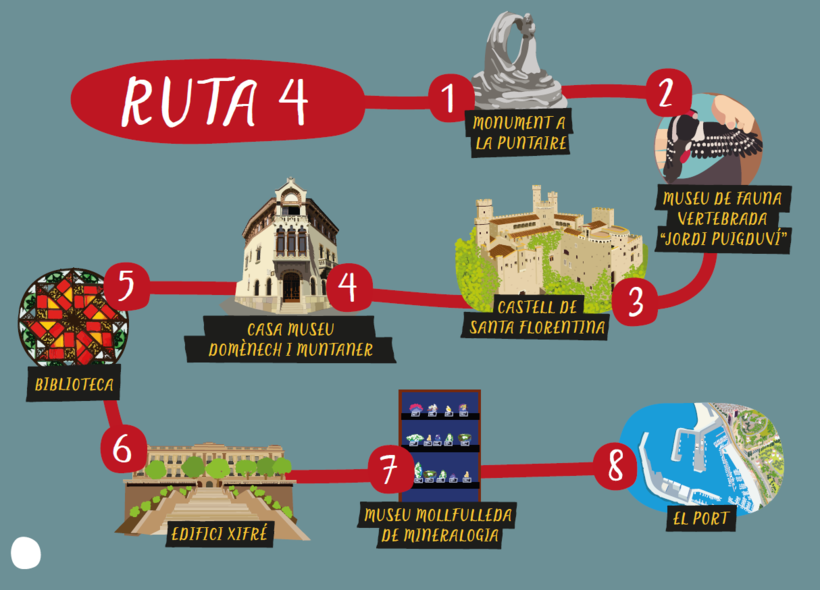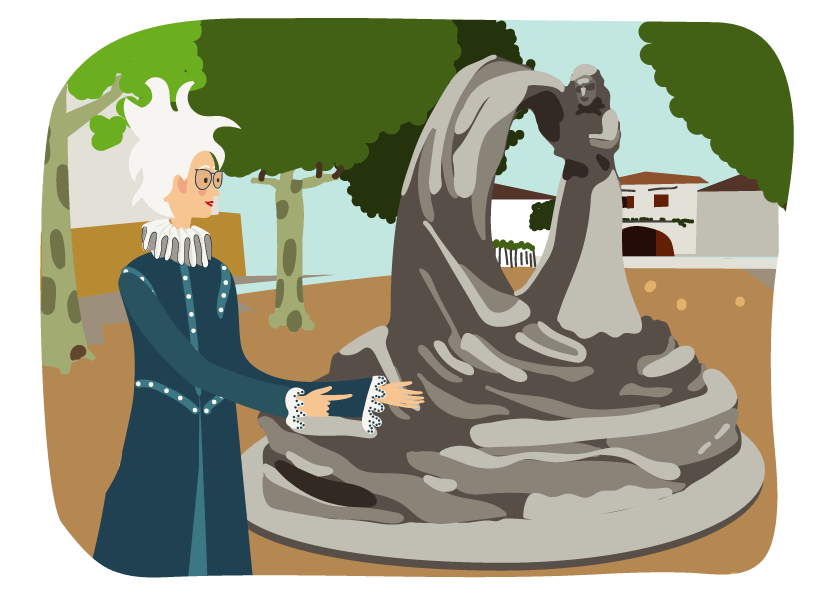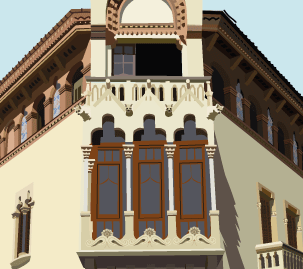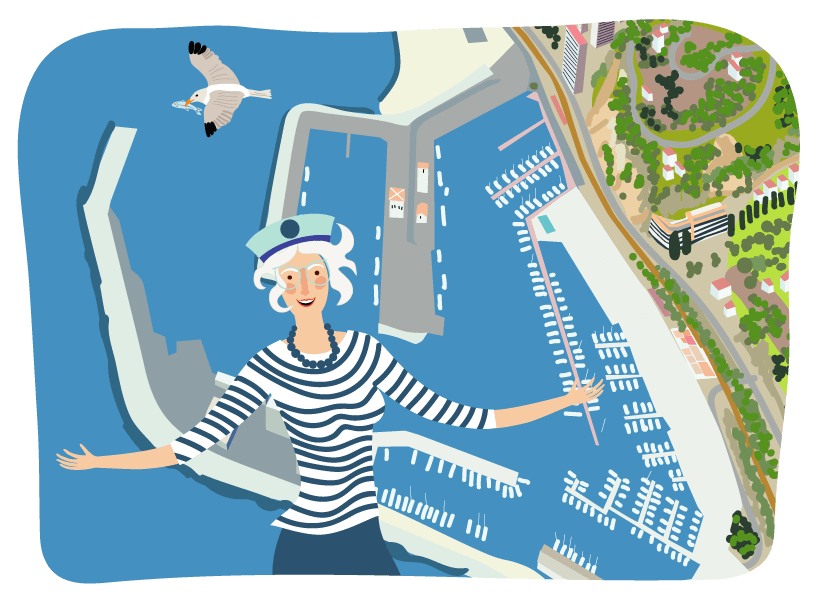Route 4: Canet de Mar - Arenys de Munt - Arenys de Mar

1. MONUMENT A LA PUNTAIRE
2. MUSEU DE FAUNA VERTEBRADA "JORDI PUIGDUVÍ"
3. CASTELL DE SANTA FLORENTINA

CASTELL DE SANTA FLORENTINA
SANTA FLORENTINA CASTLE
The Domus of Canet appears documented as early as the eleventh century since the Castle of Santa Florentina was built on an ancient Roman villa ("domus"), which was an urban centre and an area of wine production.
In the eleventh century the building became a fortified farmhouse to combat the pirate incursions of the time and it is still present today in the architectural ensemble of the castle.
In the 16th century the surname "de Montaner" was added, a lineage that still exists today.
At the end of the 19th century, Ramón de Montaner y Vila, owner of the Domus and an important businessman of Barcelona's publishing sector (Montaner i Simón Publishing House, today the headquarters of the Antoni Tàpies Foundation), commissioned his nephew, the architect from the Catalan Modernism Lluís Domènech i Montaner, to restore the Domus and expand it. He designed one by one the 3,000 m2 of living space in Santa Florentina and together with his team of the best artists of the time, he introduced colourful stained-glass windows with religious symbols, large marble weights with coffered floors, wood cut into the ceilings, stained glass windows, ceramics, wrought iron and sculptures that harmonise a balanced space full of colour, light, forms and volumes.
The final project turned this building into a residence-palace with the typical medieval and romantic touches of a castle in harmony with an aesthetic and creative modernist style. Due to this renovation inspired by medieval, modernist and neo-gothic elements it was renamed as Castle of Santa Florentina.
4. CASA MUSEU DOMÈNECH I MUNTANER

EL MODERNISME
MODERNISM
Modernism is a cultural movement that took place in Europe around the end of the 19th and the beginning of the 20th century. Although this cultural movement of searching for new forms and expressions affected all expressions of art and thought, it was in architecture and the plastic arts where it is shown with full force.
In Catalonia, Modernism adopted a special dimension and personality which can be found in very different types of buildings of the whole Catalan geography: factories, agricultural cooperatives, athenaeums, markets and houses.
The historical moment was ideal, due to the economic growth and national reaffirmation of the territory. Agriculture was focused on exports (wine, nuts), and there was an important industrial development, of the textile sector in particular. Trade and finance were flourishing in large cities, especially Barcelona, where the Medieval City Walls had become too small and an urban growth and expansion plan had begun.
This situation in Catalonia contrasts with a particularly pessimistic moment in Spain, where the loss of the last American colonies puts Spain in crisis and manifests the stagnation of its state structures and the lack of modernity of Spanish economy and society.
Modernist architecture in Catalonia meant, on the one hand, the modernisation of construction techniques (use of iron in structures and prefabricated elements), and on the other, the preservation of traditional elements (constructions with exposed brick) connected to the Gothic style with which it has certain parallelism. It is a decorative architecture that integrates all of the fine arts in the building. Architects are often also interior decorators and design all the details: furniture, marquetry, stained glass windows, mosaics, forging, etc. There is a demand for handicrafts at a time of industrial dominance.
The main features that define Modernism are the predominance of the curve over the straight line, asymmetry, dynamism of the forms, a detailed decoration in the search of an aesthetic per se, the frequent use of vegetal and natural motives and the feminine shape.
5. BIBLIOTECA
6. EDIFICI XIFRÉ

THE INDIANS
To talk about the Catalan Indians you have to look back at history.
The discovery of America opened up a new horizon of conquest, adventure and enrichment during the 16th century in Europe, and especially in Spain. America produced cotton, sugar, coffee, corn, potatoes, tobacco, cocoa, vanilla, various kinds of wood, plants to dye clothes .... and, in exchange, Europe would send finished products, shoes, textiles, etc.
At first, there were only two Spanish ports authorized to trade with America: Seville and Cadiz, but it was in the latter that an important colony of Catalans was established to begin to trade overseas. Later on, the trade ban with was overturn and 13 Spanish ports were authorized to trade with 20 American ports. From the Catalan ports of Barcelona and San Carles de la Ràpita, Palma de Mallorca and Alicante sailed many ships, which were later joined by Vilanova and Geltrú, Sitges, Mataró, Arenys de Mar, Tossa, Palafrugell, Sant Antoni de Calonge and Sant Feliu de Guíxols. They travelled mainly to Cuba, Mexico, Argentina and Venezuela.
Catalan settlements in America proliferated, especially from the end of the 18th century onwards. It was mainly people from the coast, but there were also emigrants from the more inland regions and so the figure of the "Indiano" or "Americano" was created: owners of large coffee plantations, cultivated lands, livestock but above all commercial establishments who made great fortunes and returned to Catalonia improving their economic and social status. In a way to remember the colonial atmosphere which they had lived in and had been so propitious that they built colonial-style houses: towers with porticoed galleries and surrounded by tropical gardens. But they also felt generous with their country and their native fellowmen and built schools and hospitals and invested in different industries and institutions
6. MUSEU MOLLFULLEDA DE MINERALOGIA

MUSEU MOLLFULLEDA DE MINERALOGIA
MOLLFULLEDA MUSEUM OF MINERALOGY
In 1988, Joaquim Mollfulleda i Borrell donated his mineral collection to Arenys de Mar Town Hall and a new section of the Arenys de Mar Museum was opened under the name of Museu Mollfulleda de Mineralogia. Until his death in May 2006, Joaquim Mollfulleda devoted himself to expanding the Museum's mineral collection thanks to donations of many mineralogy enthusiasts and various acquisitions.
This is actually one of the most important monographic scientific museums of Catalonia.
In the first room, the visitor gets initiated in mineralogy: What are minerals? What are they for? Where are they found? And also contemplate one of the most curious characteristics among some minerals: fluorescence.
- In the second room, there is a set of exceptional minerals distributed according to the classification established by Strunz. In this space there are pieces of great value such as the bismuth of Villanueva de Córdoba, with an exceptional 3 cm edge skeletal crystal, or the malachite of Katanga, with its set of colours and fantasy shapes that make it a remarkable piece.
- The upper floor is dedicated to mineralogy in Catalonia with samples from the different mining exploitations in the country and natural outcrops, such as the salt mines of Cardona, the fluorites of Papiol, aragonites and the diversity of minerals in the Priorat area...
7. EL PORT










